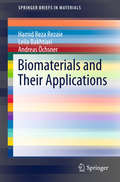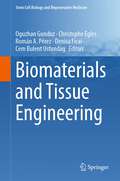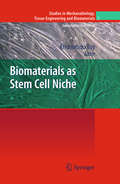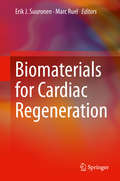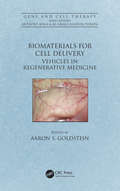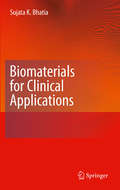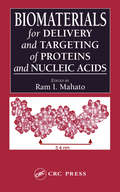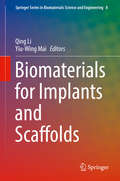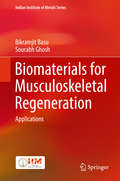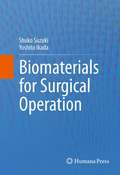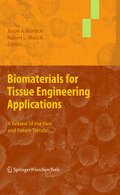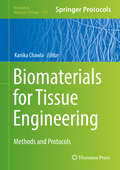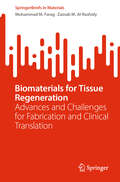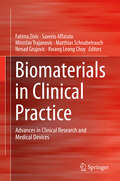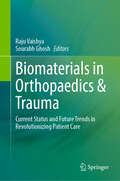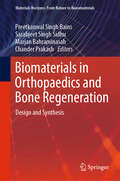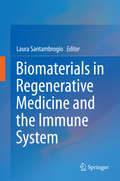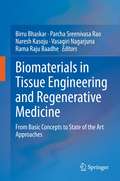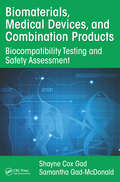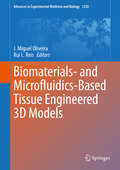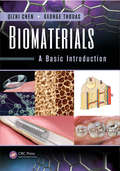- Table View
- List View
Biomaterials and Regenerative Medicine
by Peter X. MaWritten by world-leading experts, this book focusses on the role of biomaterials in stem cell research and regenerative medicine. Emphasising basic principles and methodology, it covers stem cell interactions, fabrication technologies, design principles, physical characterisation and biological evaluation, across a broad variety of systems and biomaterials. Topics include: stem cell biology, including embryonic stem cells, IPS, HSC and progenitor cells; modern scaffold structures, including biopolymer, bioceramic, micro- and nanofiber, ECM and biohydrogel; advanced fabrication technologies, including computer-aided tissue engineering and organ printing; cutting-edge drug delivery systems and gene therapy techniques; medical applications spanning hard and soft tissues, the cardiovascular system and organ regeneration. With a contribution by Nobel laureate Shinya Yamanaka, this is a must-have reference for anyone in the field of biomaterials, stem cell biology and engineering, tissue engineering and regenerative medicine.
Biomaterials and Stem Cells in Regenerative Medicine
by Seeram Ramakrishna Murugan Ramalingam Serena BestWork in the area of biomaterials and stem cell therapy has revealed great potential for many applications, from the treatment of localized defects and diseases to the repair and replacement of whole organs. Researchers have also begun to develop a better understanding of the cellular environment needed for optimal tissue repair and regeneration. Bi
Biomaterials and Their Applications (SpringerBriefs in Materials)
by Andreas Öchsner Hamid Reza Rezaie Leila BakhtiariThis short book presents an overview of different types of biomaterial such as bio ceramics, bio polymers, metals and bio composites, while especially focusing on nano biomaterials and their applications in different tissues. It provides a compact introduction to nano materials for drug delivery systems, tissue engineering and implants, while also reviewing essential trends in the biomaterial field over the last few decades and the latest developments.
Biomaterials and Tissue Engineering (Stem Cell Biology and Regenerative Medicine #74)
by Oguzhan Gunduz Christophe Egles Román A. Pérez Denisa Ficai Cem Bulent UstundagThis contributed volume covers all fundamental principles for researchers and professionals interested in the field of Biomaterials and Tissue Engineering, an interdisciplinary field of research with contributions from biomedical scientists, engineers, and physicians. With a strong focus on biomaterials and scaffolds, the book also covers testing and evaluation pathways for in vitro and in vivo studies. This book also presents a broad range of topics including fundamentals of 3D printing and bioprinting, followed by contemporary technology used in tissue engineering applications as well as currently available biomaterials suitable for tissue repair and regeneration. This volume provides information on: (i) why humans need biomaterials, especially in medical applications, (ii) different types of tissue engineering strategies, and (iii) modeling, characterization, and evaluation of outputs of those strategies. This book is a reference material in the field of tissue engineering, and it is very useful for bachelor, M.Sc., and Ph.D. students, researchers, academics, medical, industry, and healthcare professionals from diverse backgrounds.
Biomaterials as Green Flame Retardants (Engineering Materials)
by Suprakas Sinha Ray Teboho Clement Mokhena Mokgaotsa Jonas Mochane Emmanuel Rotimi SadikuThis book highlights the utilization of biomaterials as emerging suitable and effective flame retardants (FRs) to replace most of the conventional FRs (e.g., halogenated FRs). Biomaterials are considered to be sustainable, biodegradable, and renewable resources. They are abundantly available, which makes them affordable. Information and findings on the characteristics of biomaterials and their use as FRs have been explored. Herein, the tremendous scientific progress made in using biomaterials as flame retardants for a wide range of products is elucidated. The major goal is to draw attention to the opportunities and challenges of switching to biomaterial-based FRs in place of conventional FRs in order to create a sustainable society.
Biomaterials as Stem Cell Niche (Studies in Mechanobiology, Tissue Engineering and Biomaterials #2)
by Krishnendu RoyRecent developments in stem cell biology have opened new directions in cell therapy. This book provides the state-of-the-art developments in using biomaterials as artificial niches for engineering stem cells, both for the purpose of better understanding their biology under 3D biomimetic conditions as well as for developing new strategies for efficient long term maintenance and directed differentiation of stem cells into various therapeutic lineages. Animal and human stem cells of both embryonic and adult origin are discussed with applications ranging from nerve regeneration, orthopedics, cardiovascular therapy, blood cell generation and cancer therapy. Both synthetic and natural biomaterials are reviewed with emphasis on how material-stem cell interactions direct specific signaling pathways and ultimately modulate the cell fate. This book is valuable for biomaterial scientists, tissue engineers, clinicians as well as stem cell biologists involved in basic research and applications of adult and embryonic stem cells.
Biomaterials for Cardiac Regeneration
by Erik J. Suuronen Marc RuelThis book offers readers a comprehensive biomaterials-based approach to achieving clinically successful, functionally integrated vasculogenesis and myogenesis in the heart. Coverage is multidisciplinary, including the role of extracellular matrices in cardiac development, whole-heart tissue engineering, imaging the mechanisms and effects of biomaterial-based cardiac regeneration, and autologous bioengineered heart valves. Bringing current knowledge together into a single volume, this book provides a compendium to students and new researchers in the field and constitutes a platform to allow for future developments and collaborative approaches in biomaterials-based regenerative medicine, even beyond cardiac applications.
Biomaterials for Cell Delivery: Vehicles in Regenerative Medicine (Gene and Cell Therapy)
by Aaron S. GoldsteinThe purpose of this book is to summarize key strategies and recent accomplishments in the area of developing cell/biomaterial constructs for regenerative medicine. The first section is a review of the state-of-the-art of biomaterial carriers and is divided into synthetic and natural materials. A subset of the latter are decellularized organs which retain the structure and some of the biological activities of the target organ. The bulk of the book is devoted to unique problems associated with key tissue and organ targets. Key selling features: Describes developing cell/biomaterial constructs for regenerative medicine Reviews state-of-the-art of biomaterial carriers Summarizes the unique problems associated with key tissue and organ targets Discusses issues associated with clinical translation including quality control, manufacturing practices, nondestructive imaging, and animal models
Biomaterials for Clinical Applications: Novel Technologies For Clinical Applications
by Sujata K. BhatiaBiomaterials for Clinical Applications is organized according to the World Health Organization's report of the top 11 causes of death worldwide, and lays out opportunities for both biomaterials scientists and physicians to tackle each of these leading contributors to mortality. The introductory chapter discusses the global burden of disease. Each of the subsequent eleven chapters focuses on a specific disease process, beginning with the leading cause of death worldwide, cardiovascular disease. The chapters start with describing diseases where clinical needs are most pressing, and then envisions how biomaterials can be designed to address these needs, instead of the more technologically centered approached favored by most books in the field. This book, then, should appeal to chemical engineers and bioengineers who are designing new biomaterials for drug delivery and vaccine delivery, as well as tissue engineering.
Biomaterials for Delivery and Targeting of Proteins and Nucleic Acids
by Ram I. MahatoNewcomers to the field of biopharmaceuticals require an understanding of the basic principles and underlying methodology involved in developing protein- and nucleic acid-based therapies for genetic and acquired diseases.Introducing the principles of polymer science and chemistry, this book delineates the basic biology required for understanding how biomaterials can be used as drug-deliver vehicles. No book to date combines a discussion of high-tech biomaterials-based delivery of protein and nucleic acid drugs with the pharmaceutical or biocompatibility aspects. Leading experts from around the world discuss the physiochemical parameters used for design, development, and evaluation of biotechnological dosage forms for delivery of proteins, peptides, oligonucleotides, and genes. The book includes coverage biological barriers to extravasation and cellular uptake of proteins and nucleic acids.
Biomaterials for Implants and Scaffolds (Springer Series in Biomaterials Science and Engineering #8)
by Qing Li Yiu-Wing MaiThis book highlights the latest, cutting-edge advances in implantable biomaterials. It brings together a class of advanced biomaterials in two highly active research areas, namely implants and tissue scaffolds, to underline their respective functional requirements for further development. It is unique in providing a full range of methodological procedures, including materials syntheses, characterisation, cellular tests and mathematical modelling. Covering metallic, ceramic, polymeric and composite materials commonly used in biological applications and clinical therapeutics, it is a valuable resource for anyone wanting to further their understanding of the latest developments in implantable biomaterials. Focusing on biomedical applications in implants and scaffolds, it provides methodological guides to this rapidly growing field. Qing Li and Yiu-Wing Mai are both professors at the University of Sydney School of Aerospace, Mechanical and Mechatronic Engineering.
Biomaterials for Musculoskeletal Regeneration: Applications (Indian Institute of Metals Series)
by Bikramjit Basu Sourabh GhoshThis book discusses a number of case studies to showcase the translation of research concepts to lab-scale materials development for biomedical applications. The book intends to motivate active researchers to develop new generation biomaterials. This book is meant for readers, who are already familiar with the broad area of biomaterials. The book introduces readers to the field of additive manufacturing of biomaterials and teaches them how to extend this innovative processing approach to a variety of biomaterials for musculoskeletal applications. It covers both in vitro and in vivo biocompatibility and toxicity assessment for a broad range of biomaterials in the context of bone tissue engineering. It works to sensitise researchers in the field of translational biomedical engineering on the importance of clinical trials and discusses the challenges ahead in this important field of research. This book will be useful to clinicians, professionals and researchers alike.
Biomaterials for Musculoskeletal Regeneration: Concepts (Indian Institute of Metals Series)
by Bikramjit BasuThis book covers the basics of the biomaterials science its applications to bone tissue engineering. The introductory section describes the most necessary concepts and techniques related to the cell and molecular biology with a particular focus on evaluating the biocompatibility property. The layout of this book facilitates easier understanding of the area of bone tissue engineering. The book integrates the Materials Science and Biological Science. It covers processing and basic material properties of various biocompatible metals and ceramics-based materials, in vitro and in vivo biocompatibility and toxicity assessment in the context of bone tissue engineering, and processing and properties of metal-, ceramic- and polymer-based biocomposites, including the fabrication of porous scaffold materials. The book can be used as a textbook for senior undergraduate and graduate coursework. It will also be a useful reference for researchers and professionals working in the area.
Biomaterials for Surgical Operation
by Yoshito Ikada Shuko SuzukiBiomaterials for Surgical Operation offers a review of the latest advances made in developing bioabsorbable devices for surgical operations which include surgical adhesives (sealants), barriers for the prevention of tissue adhesion, polymers for fractured bone fixation, growth factors for the promotion of wound healing, and sutures. Over the years, many descriptions of biomaterials have appeared in academic journals and books, but most of them have been devoted to limited clinical areas. This is in marked contrast with this volume which covers a wide range of bioabsorbable devices used in surgery from a practical point of view. The currently applied polymeric devices are critical in surgery, but all involve serious problems due to their poor performance. For instance, fibrin glue, the most widely used surgical sealant, can produce only a weak gel with low adhesive strength to tissues, accentuating the limited effectiveness of current treatment options. Likewise, the currently available barrier membranes cannot fully prevent tissue adhesion at the acceptable level and are, moreover, not easy to handle with endoscopes due to their poor mechanical properties. Biomaterials for Surgical Operation is aimed at those who are interested in expanding their knowledge of how the problems associated with the currently used devices for surgical operation can be solved. It primarily focuses on the absorbable biomaterials which are the main components of these medical devices.
Biomaterials for Tissue Engineering Applications: A Review of the Past and Future Trends
by Robert L. Mauck Jason A. BurdickA concise overview of tissue engineering technologies and materials towards specific applications, both past and potential growth areas in this unique discipline is provided to the reader. The specific area of the biomaterial component used within the paradigm of tissue engineering is examined in detail. This is the first work to specifically covers topics of interest with regards to the biomaterial component. The book is divided into 2 sections: (i) general materials technology (e.g., fibrous tissue scaffolds) and (ii) applications in the engineering of specific tissues (e.g., materials for cartilage tissue engineering). Each chapter covers the fundamentals and reflects not only a review of the literature, but also addresses the future of the topic. The book is intended for an audience of researchers in both industry and academia that are interested in a concise overview regarding the biomaterials component of tissue engineering, a topic that is timely and only growing as a field.
Biomaterials for Tissue Engineering: Methods And Protocols (Methods In Molecular Biology #1758)
by Kanika ChawlaThis volume provides protocols for the generation of various biomaterials for tissue engineering and regenerative medicine applications. The chapters in this book include a look at a range of biomaterials including hydrogels and other matrices (natural, synthetic, self-healing) for various applications including drug and gene delivery, surface modification and functionalization of biomaterials. In addition, techniques described include those for controlling biomaterial geometry, such as three-dimensional printing and electrospinning. Written in the highly successful Methods in Molecular Biology series format, chapters include introductions to their respective topics, lists of the necessary materials and reagents, step-by-step, readily reproducible laboratory protocols, and tips on troubleshooting and avoiding known pitfalls.Cutting-edge and thorough, Biomaterials for Tissue Engineering: Methods and Protocols is a valuable resource for scientists and engineers interested in this vital field of study.
Biomaterials for Tissue Regeneration: Advances and Challenges for Fabrication and Clinical Translation (SpringerBriefs in Materials)
by Mohammad M. Farag Zainab M. Al-RashidyThis book comprehensively reviews the essential characteristics of biomaterials and their designs important for applications in tissue regeneration. It delves into both past research milestones in tissue engineering and emerging trends poised for future integration. The primary focus lies on the evolution of biomaterial generations and the burgeoning domain of tissue engineering discovery. Furthermore, it examines various biomaterial categories, including bioceramics, bioactive glasses, synthetic and natural polymers, alongside their composite derivatives, all pivotal in scaffold fabrication, a cornerstone of tissue engineering. The book also looks at diverse scaffold fabrication methodologies, providing readers with a thorough understanding of the technical intricacies involved. The book showcases recent breakthroughs in tissue engineering across multiple fronts such as bone, skin, cartilage, neural, and cardiac regeneration, highlighting their potential as pre-clinical interventions for rehabilitating injured or diseased tissues and organs. Finally, it reviews the contemporary landscape of biomaterials for tissue regeneration, shedding light on emerging trends and confronting the challenges that lie ahead.
Biomaterials in Clinical Practice: Advances in Clinical Research and Medical Devices
by Fatima Zivic Nenad Grujovic Saverio Affatato Miroslav Trajanovic Matthias Schnabelrauch Kwang Leong ChoyThis book covers the properties of biomaterials that have found wide clinical applications, while also reviewing the state-of-the-art in the development towards future medical applications, starting with a brief introduction to the history of biomaterials used in hip arthroplasty. The book then reviews general types of biomaterials - polymers, ceramics, and metals, as well as different material structures such as porous materials and coatings and their applications - before exploring various current research trends, such as biodegradable and porous metals, shape memory alloys, bioactive biomaterials and coatings, and nanometals used in the diagnosis and therapy of cancer. In turn, the book discusses a range of methods and approaches used in connection with biomaterial properties and characterization - chemical properties, biocompatibility, in vivo behaviour characterisation, as well as genotoxicity and mutagenicity - an d reviews various diagnostic techniques: histopathological analysis, imagining techniques, and methods for physicochemical and spectroscopic characterization. Properties of stent deployment procedures in cardiovascular surgeries, from aspects of prediction, development and deployment of stent geometries are presented on the basis of novel modelling approaches. The last part of the book presents the clinical applications of biomaterials, together with case studies in dentistry, knee and hip prosthesis. Reflecting the efforts of a multidisciplinary team of authors, gathering chemical engineers, medical doctors, physicists and engineers, it presents a rich blend of perspectives on the application of biomaterials in clinical practice. The book will provide clinicians with an essential review of currently available solutions in specific medical areas, also incorporating non-medical solutions and standpoints, thus offering them a broader selection of materials and implantable solutions. This work is the result of joint efforts of various academic and research institutions participating in WIMB Tempus project, 543898-TEMPUS-1-2013-1-ES-TEMPUS-JPHES, "Development of Sustainable Interrelations between Education, Research and Innovation at WBC Universities in Nanotechnologies and Advanced Materials where Innovation Means Business", co-funded by the Tempus Programme of the European Union.
Biomaterials in Orthopaedics & Trauma: Current Status and Future Trends in Revolutionizing Patient Care
by Sourabh Ghosh Raju VaishyaThe landscape of orthopaedics and trauma is rapidly evolving, driven by groundbreaking advancements in biomaterials. This book offers an in-depth exploration of the current state-of-the-art, highlighting the latest innovations and their clinical applications. The intersection of materials science and medicine has given rise to a revolutionary field: biomaterials. These engineered substances, designed to interact with biological systems, have become indispensable in orthopaedics and trauma surgery. From repairing broken bones to replacing worn-out joints, biomaterials have significantly advanced patient care and quality of life. In recent years, the focus has shifted towards bioactive and biodegradable materials. Bioactive materials, such as calcium phosphate ceramics, actively interact with bone tissue, promoting bone growth and integration. This characteristic is particularly valuable in bone grafts and tissue engineering applications. On the other hand, biodegradable materials, like polylactic acid (PLA) and polyglycolic acid (PGA), offer the advantage of being gradually absorbed by the body as the surrounding tissue regenerates. These materials are employed in various forms, including screws, plates, and bone scaffolds. This book offers a holistic view of biomaterials in orthopaedics and trauma by presenting an understanding of the fundamental properties of biomaterials and exploring their role in tissue regeneration and implant design. This comprehensive resource also delves into the future, examining emerging trends and technologies that are revolutionizing patient care and paving the way for new treatment modalities. This book is an essential guide to the exciting world of biomaterials for orthopaedic surgeons, trauma surgeons and biomedical researchers.
Biomaterials in Orthopaedics and Bone Regeneration: Design and Synthesis (Materials Horizons: From Nature to Nanomaterials)
by Sarabjeet Singh Sidhu Preetkanwal Singh Bains Chander Prakash Marjan BahraminasabThis book focuses on the recent advances in the field of orthopaedic biomaterials, with a particular emphasis on their design and fabrication. Biomimetic materials, having similar properties and functions to that of the natural tissue, are becoming a popular choice for making customized orthopaedic implants and bone scaffolds. The acceptability of these materials in the human body depends on the right balance between their mechanical and biological properties. This book provides a comprehensive overview of the state-of-the-art research in this rapidly evolving field. The chapters cover different aspects of multi-functional biomaterials design, and cutting-edge methods for the synthesis and processing of these materials. Advanced manufacturing techniques, like additive manufacturing, used for developing new biomimetic materials are highlighted in the book. This book is a valuable reference for students and researchers interested in biomaterials for orthopaedic applications.
Biomaterials in Regenerative Medicine and the Immune System
by Laura SantambrogioThe generation of tridimensional tissues, assembled from scaffolding materials populated with biologically functional cells, is the great challenge and hope of tissue bioengineering and regenerative medicine. The generation of biomaterials capable of harnessing the immune system has been particularly successful. This book provides a comprehensive view of how immune cells can be manipulated to suppresses inflammation, deliver vaccines, fight cancer cells, promote tissue regeneration or inhibit blood clotting and bacterial infections by functionally engineered biomaterials. However, long-lived polymers, such as those employed in orthopedic surgery or vascular stents, can often induce an immune reaction to their basic components. As a result, this book is also an important step towards coming to understand how to manipulate biomaterials to optimize their beneficial effects and downplay detrimental immune responses.
Biomaterials in Tissue Engineering and Regenerative Medicine: From Basic Concepts to State of the Art Approaches
by Birru Bhaskar Parcha Sreenivasa Rao Naresh Kasoju Vasagiri Nagarjuna Rama Raju BaadheThis book comprehensively explores the basic concepts and applications of biomaterials in tissue engineering and regenerative medicine. The book is divided into four sections; the first section deals with the basic concepts and different types of biomaterials used in tissue engineering. The second section discusses the functional requirements and types of materials that are used in developing state-of-the-art of scaffolds for tissue engineering applications. The third section presents the applications of biomaterials for hard and soft tissue engineering, as well as for specialized tissue engineering. The last section addresses the future prospects of nanobiomaterials, intelligent biomaterials, and 3D bioprinting biomaterials in tissue engineering and regenerative medicine. It also discusses various in vitro disease models for tissue bioengineering and regenerative medicine. As such, it offers a valuable resource for students, researchers, scientists, entrepreneurs, and medical/healthcare professionals.
Biomaterials, Medical Devices, and Combination Products: Biocompatibility Testing and Safety Assessment
by Shayne Cox Gad Samantha Gad-McDonaldBiomaterials, Medical Devices, and Combination Products is a single-volume guide for those responsible for-or concerned with-developing and ensuring patient safety in the use and manufacture of medical devices.The book provides a clear presentation of the global regulatory requirements and challenges in evaluating the biocompatibility and clinical
Biomaterials- and Microfluidics-Based Tissue Engineered 3D Models (Advances in Experimental Medicine and Biology #1230)
by Rui L. Reis J. Miguel OliveiraThis contributed volume reviews the latest advances on relevant 3D tissue engineered in vitro models of disease making use of biomaterials and microfluidics. The main focus of this book is on advanced biomaterials and microfluidics technologies that have been used in in vitro mimetic 3D models of human diseases and show great promise in revolutionizing personalized medicine. Readers will discover important topics involving biomaterials and microfluidics design, advanced processing techniques, and development and validation of organ- and body-on-a-chip models for bone, liver, and cancer research. An in depth discussion of microfabrication methods for microfluidics development is also provided. This work is edited by two truly multidisciplinary scientists and includes important contributions from well-known experts in their fields. The work is written for both early stage and experienced researchers, and well-established scientists enrolled in the fields of biomaterials, microfluidics, and tissue engineering, and is especially suited to those who wish to become acquainted with the principles and latest developments of in vitro models of diseases, such as professionals working in pharma, medicine, and engineering.
Biomaterials: A Basic Introduction
by Qizhi Chen George ThouasExplores Biomedical Science from a Unique PerspectiveBiomaterials: A Basic Introduction is a definitive resource for students entering biomedical or bioengineering disciplines. This text offers a detailed exploration of engineering and materials science, and examines the boundary and relationship between the two. Based on the author's course lectur


